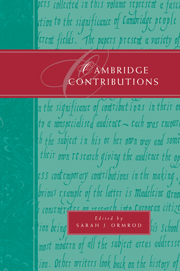Book contents
- Frontmatter
- Contents
- Notes on contributors and contributions
- Preface
- 1 Some Cambridge contributions to astronomy and cosmology
- 2 Cambridge's contribution to medical science
- 3 Cambridge and the study of English
- 4 The Cambridge contribution to economics
- 5 ‘Nasty forward minxes’: Cambridge and the higher education of women
- 6 Cambridge Classics for the third millennium
- 7 Cambridge contributions: the philosophy of science
- 8 European citizenship and education
- 9 The University Botanic Garden
- 10 Geophysics in Cambridge: extinct and active volcanoes
- 11 Cambridge spies: the ‘Magnificent Five’, 1933–1945
10 - Geophysics in Cambridge: extinct and active volcanoes
Published online by Cambridge University Press: 31 December 2009
- Frontmatter
- Contents
- Notes on contributors and contributions
- Preface
- 1 Some Cambridge contributions to astronomy and cosmology
- 2 Cambridge's contribution to medical science
- 3 Cambridge and the study of English
- 4 The Cambridge contribution to economics
- 5 ‘Nasty forward minxes’: Cambridge and the higher education of women
- 6 Cambridge Classics for the third millennium
- 7 Cambridge contributions: the philosophy of science
- 8 European citizenship and education
- 9 The University Botanic Garden
- 10 Geophysics in Cambridge: extinct and active volcanoes
- 11 Cambridge spies: the ‘Magnificent Five’, 1933–1945
Summary
Geophysics is the study of the structure and dynamical evolution of the Earth using the concepts of physics in a quantitative manner. Like many branches of physics, the study of geophysics can be considered to have commenced with Sir Isaac Newton, who occupied the Lucasian Professorship in Cambridge from 1669 to 1701 (the current occupant being Stephen Hawking). Before the time of Newton, our knowledge of the structure of the Earth was rather vague. Aside from knowledge of the transparent atmosphere and neighbouring oceans, extrusion of hot, smelly liquid from volcanoes on the Earth's surface gave rise to the notion of a predominantly solid Earth in which there were interconnected vast subterranean caverns of hot sulphurous material - somewhat consistent with the then current views of Hell.
The quantification of Newton's inverse square law of gravitation allowed the Earth to be ‘weighed’. This was done in 1775 by measuring the deflection of a ‘Vertical’ plumb bob by the mountain Schiehallion in Scotland at various distances from it. These measurements allowed the total mass of the attracting Earth to be estimated at 5 X 1024 kg. With the known mean radius of the Earth of around 6,400 km the result suggested a mean density of 4,500kg m-3 (modern measurements give 5,520 kg m-3) in sharp contrast to the measured mean density of 2,500 kg m-3 of almost all near surface rocks, including those that make up Schiehallion.
- Type
- Chapter
- Information
- Cambridge Contributions , pp. 186 - 207Publisher: Cambridge University PressPrint publication year: 1998



